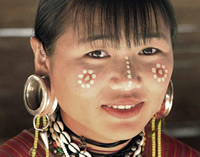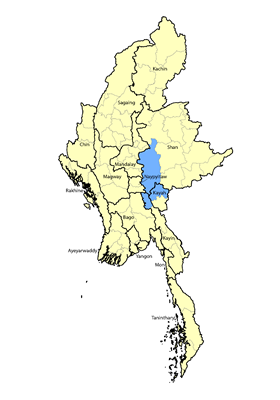Although other ethnicities describe this tribe as the Red Karen or Karenni (“ni” means red), their autonym is Kayahli, and they claim to have always been distinct from the Karen. Some scholars believe their claims of independence stem from the fact that they had local chiefs with hereditary titles, which the British recognized in 1875. As a result, Kayah State was never fully incorporated into British Burma.
Location: More than 160,000 Western Kayah people live in the dense forests and towering mountains of eastern Myanmar's Kayah and Kayin states. Others are further north in Shan State and as far south as the Bago Region. The Salween River, which originates in Tibet and flows 2,044 miles (3,289 km) to the Andaman Sea, is known as the Thanlwin River in Myanmar, after a plant that grows along its banks. More than 20,000 Western Kayah now live in refugee camps in Thailand. The first camp was established in 1992, and many families who have fled rape and ethnic cleansing in their homeland have dwelt there for decades. By 2004, 19,177 Kayah people populated the camps, while thousands more have managed to reside illegally in Thailand. An estimated 10,000 Western Kayah people have been resettled as refugees in the United States and other Western nations.
Language: Western Kayah is divided into 11 dialects, distributed among more than 100 villages over a large area. In Kayah State, the Western Kayah divide into those north of Loikaw, who speak the northern dialect, and those south of Loikaw (southern dialect). Western Kayah enjoys widespread use, although some people also use S'gaw Karen or Burmese, especially Baptists who have had to read Bibles in those languages for generations. Only about 10 percent of Western Kayah can read their own language today.
For many generations outsiders trembled at the thought of meeting a Kayah, given the tribe's well-deserved reputation as slave traders and fierce warriors.3 In 1947, Karenni State "was granted the right of secession after a ten-year period within the Union of Burma, but in August 1948, the Kayah leader U Bee Htu Re was assassinated by the government. An armed uprising took place, which has continued to the present day." Karenni State was renamed Kayah in 1951 by its leaders to show the world they are different from the Karen. The right of the Kayah to secede was revoked in 1974, and a brutal civil war has ensued since between the Burmese and three separate Kayah independence armies.
Despite living under extreme hardship, the Kayah are renowned for their warm hospitality. They are “a resilient, gracious people with a great sense of humor. They have a very strong work ethic, and don't complain…. They demonstrate great dignity in providing for themselves and helping others. Unfortunately, it is very difficult for them to ask for help, even if they desperately need it. They might be almost completely out of food, yet they will give you the last food they have if you come to visit.”
For countless centuries, the Kayah had a religion called Kan Khwan, which included a belief that their race resulted from a union between a female dragon and a hybrid being that was part human and part angel. Despite many Western Kayah now professing faith in Christ, animistic beliefs persist. In many villages no major decision is made without first consulting a diviner, who reads chicken bones to determine the will of the spirits.
The first known Western Kayah Christian was a man named Ngapah in 1871. Over the decades, the Western Kayah church has ebbed and flowed, and despite their long Christian history, the New Testament was translated into Western Kayah only recently, in 2009. By 2024, 15 Old Testament books had also been completed, and in the coming years the entire Bible should be available. The Jesus film is available in Western Kayah.
Scripture Prayers for the Kayah (Western) in Myanmar (Burma).
| Profile Source: Asia Harvest |












